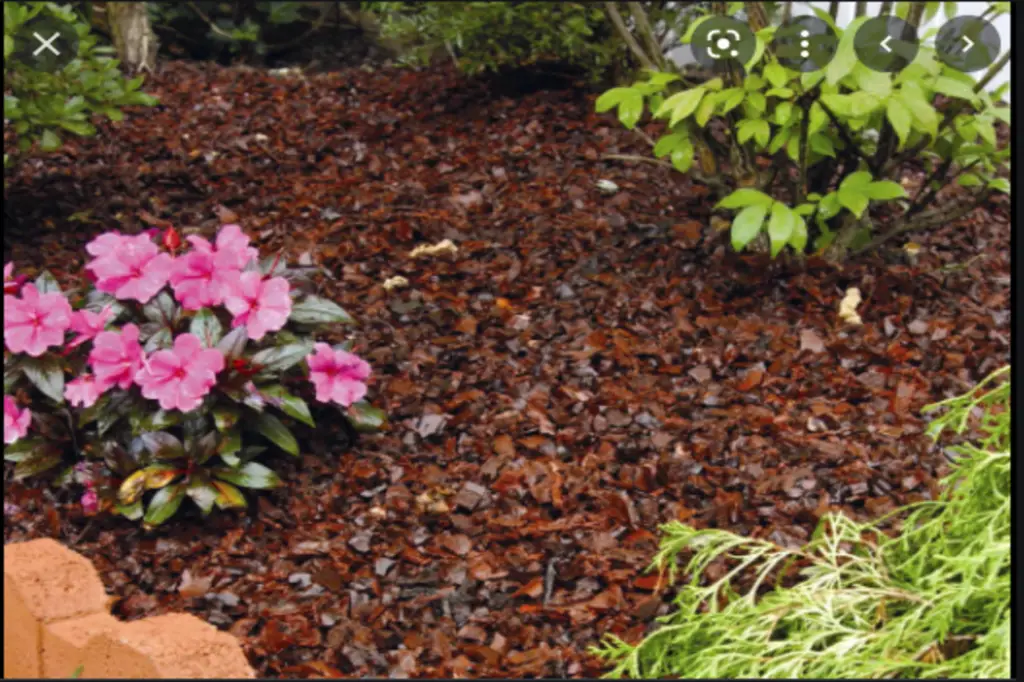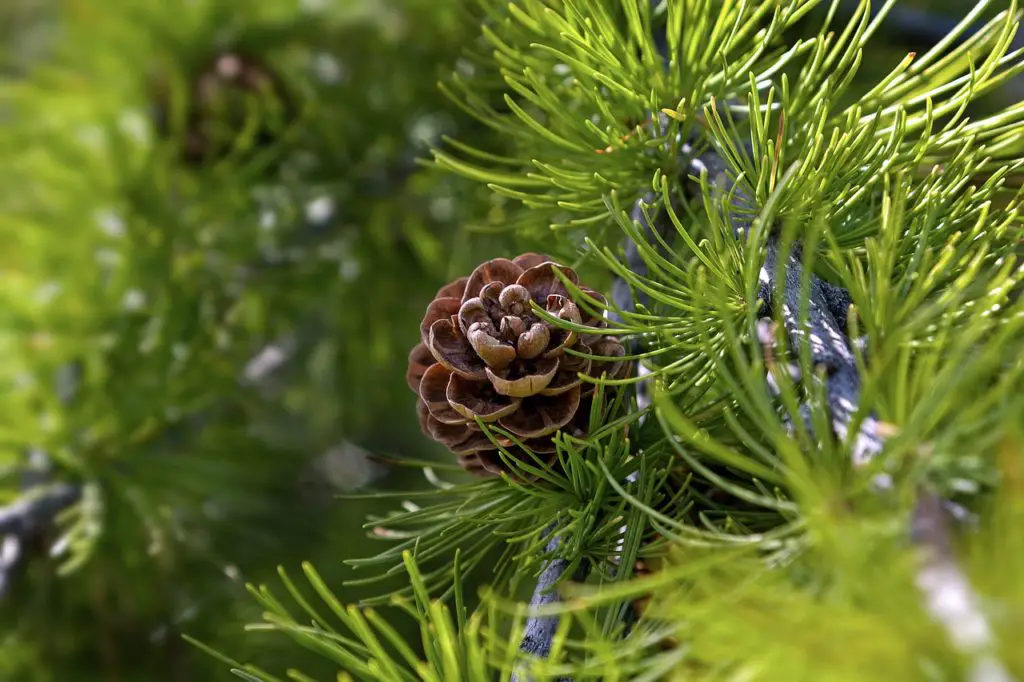Do you find weeds a bother in your flower garden? Are you also facing problems such as; soil erosion, quick loss of soil moisture, and pest or disease attack? Are your flowers showing signs of slow growth rates? Use rubber mulch!
Use rubber mulch around flowers. However, plant flowers before installing rubber mulch. To plant flowers in rubber mulch, dig around your flowers and install your mulch, at least up to 6 inches deep. Rubber mulch may kill flowers after a while since it contains zinc (in small quantities).
With all the benefits therein of rubber mulch in flowers as well as cons, how do you plant your flowers in rubber mulch?
Let’s dive in to learn. However, read till the end because I’ll also be discussing
But…
Should You Mulch Around Flowers?
Yes, you can mulch around flowers. Mulching helps keep your flowers attractive and healthy. Mulching also keeps your garden clean since it keeps weeds away. This protects your flower roots and keeps your soil moist.
Some other added advantages of mulching are;
- Provides a living ground cover
- Prevents infections and diseases
- Decomposes, hence adding nutrients to the soil
How To Plant Flowers In Rubber Mulch
Below is a five-step method on how to plant flowers in rubber mulch.
- Identify a garden to plant your flowers: The garden should have availability of sun and a bit of shade to protect the flowers from the hot, scorching sun. Always recall that most flowers need about 6 hours of sunlight per day.
- Dig holes for your flowers. The holes should be wide and deep enough. Why? This is because they help bulge the roots at the base, thus preventing the flowers from bending.
- Add about 3 to 4 inches of compost manure. Mix the compost manure with the soil you removed out of the hole.
- Set your flowers in the holes. This makes sure that the roots are well distributed. After this, cover the flower with the soil-compost mixture and water. Make sure you water enough so that it settles deep in the roots. Also, the soil-compost combination is vital since it provides nutrients for the flowers’ growth.
- Lastly, spread out the rubber mulch at the base of the plant and leave the area around the stem. Apply 2 to 3 inches of mulch, then ensure it’s evenly spread out around the flower.
Do Flowers Grow Well With Rubber Mulch?
Yes, flowers do grow well with rubber mulch. Here’s why. Without rubber mulch, your flowers are prone to insect infestation, and fungi plus weeds. Consequently, you’ll be sure of evergreen flowers all year round.
Besides, since the soil around your flowers will be moist even during summers (of course, as long as you continue to water them), the glory of your flowers will never fade away. That’s why flowers do well with rubber mulch.
Advantages Of Growing Flowers Using Rubber Mulch
Growing flowers using rubber mulch has lots of advantages.
- While other mulches retain nutrients, rubber mulch allows them to pass through to the roots—thereby boosting the growth of the flowers.
- No pests mean there’s less cost—hence economical for you
- Rubber mulch insulates crops from high temperatures that may damage flowers.
- It reduces soil erosion mostly in winters and heavy rainfall seasons
- It helps suppress weed growth— thus avoiding sharing of nutrients between flowers and the weeds
- Helps retain moisture in summer seasons that may cause flowers to dry and wither
- Guards plants against pests infection since it’s synthetic
Cons Of Using Rubber Mulch For Flowers
Here’s the negative part of using rubber mulch in your flower garden.
- Mulch requires weeding by hand for good maintenance
- Rubber mulch is quite expensive compared to other mulch products
- Rubber mulch has a high degree of flammability and thus calls for proper attention
- It’s difficult and tedious to remove mulch from the ground
Will Rubber Mulch Hurt Flowers; Does Rubber Mulch Kill Flowers?
Rubber mulch won’t hurt flowers; even so, this changes after some time. This is due to the small amounts of zinc in rubber mulch, which may affect the soil after some time. Resultantly, there may be a chemical overload that is most likely to kill your flowers.
Also, using rubber mulch in your landscape is not that bad of an idea. You may adopt preventive measures which could help you avoid chemical overload.
Can You Put Mulch Down Before Planting Flowers?
Yes, you can put mulch before planting flowers—it’s the most effective way. Why? If you mulch after planting flowers, the soil mixes with rubber mulch, thereby minimizing the amount of nitrogen reaching the roots of the flowers. This happens due to soil microbes breaking down the organic matter.
Also, to effectively stop weeds from germinating around the flowers, mulching should be done after planting flowers.
When mulching, though, leave 1-2 (if you wish, 3) inches between the flower stems and the mulch. Else, your flowers will rot.
Can I Plant Flowers After Mulching?
You probably didn’t know you should install mulch after planting flowers and you already installed it. What do you, therefore? It’s not lost, yet.
You can plant flowers after mulching, though it becomes really tedious.
Here’s how to go about it:
- Scrape the mulch, ensure it’s not mixed up with the soil, and place it aside.
- To avoid doing tedious work, scrape only about 5 inches from where you intend to plant your flowers.
- Dig holes for your flowers, put the soil in a bucket to ensure you don’t soil your mulch, then plant them.
- Use the soil in the bucket when planting the flowers.
- Install mulch back, but ensure to leave at least 1 to 2 (or 3) inches from the flower stems to your reinstalled mulch.
How Do You Lay Rubber Mulch In A Flower Bed?
You lay rubber mulch in a flower bed by:
- By preparing the place you want to plant your flowers. To do so, dig, remove weeds, and rocks.
- To ensure water doesn’t drain to your home or nearby structures, ensure the area slopes away. Do so by grading the flower bed to-be so that it falls away to about one inch of every 10ft.
- To ensure weeds don’t have a breathing zone, spray an effective weed killer on the excavated area.
- Cover the sprayed area with landscaping fabric, must be permeable fabric to prevent creating room for fungus due to excess moisture retention.
- To secure the fabric, it’s necessary to install edging—and use it to anchor the landscaping fabric
- For sufficient stability, dig a trench that is equal to the width of the edging material. Ensure it’s also deep so that it buries the fabric halfway.
- Evenly spread the rubber mulch and ensure the entire area is evenly covered, at least, install 2 to 4 inches of rubber mulch.
FAQs
Is Rubber Mulch Good For Potted Flowers?
Rubber mulch is good for potted flowers. Why? After watering your plants, it won’t absorb water. Still, it’s non-porous—thus, moisture and fertilizers reach the potted flowers’ roots easily without any interference.
In addition, it smoothens weeds—thereby, becoming impossible for them to germinate. Additionally, rubber mulch offers nutrients to the soil after decomposing. This is very encouraging since it helps in forming a good soil structure.
Is Rubber Mulch Good For Roses?
Rubber mulch is good for roses because it helps in the conservation of soil moisture during high temperatures. Besides, it also slows down the process of water evaporation, thereby keeping your roses glowing.
Nonetheless, shredded rubber may not benefit your roses, instead, it may harm them. Here’s why. They slow down the movement of water into the roses’ stems.
Worse still is that once water gets into the stems, it doesn’t dry fast so your roses are more prone to withering than glowing!
Can Perennials Grow Through Mulch?
Like roses, perennials grow through mulch. The season you’ve planted them, though, affects how they’ll grow. Here’s what I’m saying.
Young perennials planted in the Autumn, may not succeed in piercing through the mulch. So, to help them grow, clear some few inches of mulch during the springtime. This is the case if you had installed about 4 to 6 inches of mulches–which is the recommended amount.
This way, your perennials grow successfully without any hindrances.
Verdict
How to plant flowers in rubber mulch has never been as easy as now. This guide simplest the entire concept. One mistake people make is mulching after planting flowers. While it’s correctable, it’s tedious and time-wasting.
Plus, your rubber mulch loses its glory since it is soiled. Avoid this. Mulch before planting flowers. Also, avoid mulching too close to the stems of your flowers. Leave a few inches to prevent the stems from rotting.
Also, before installing the mulch, dig deep holes for mulch installation–at least 4 inches deep, utmost 6 inches.


